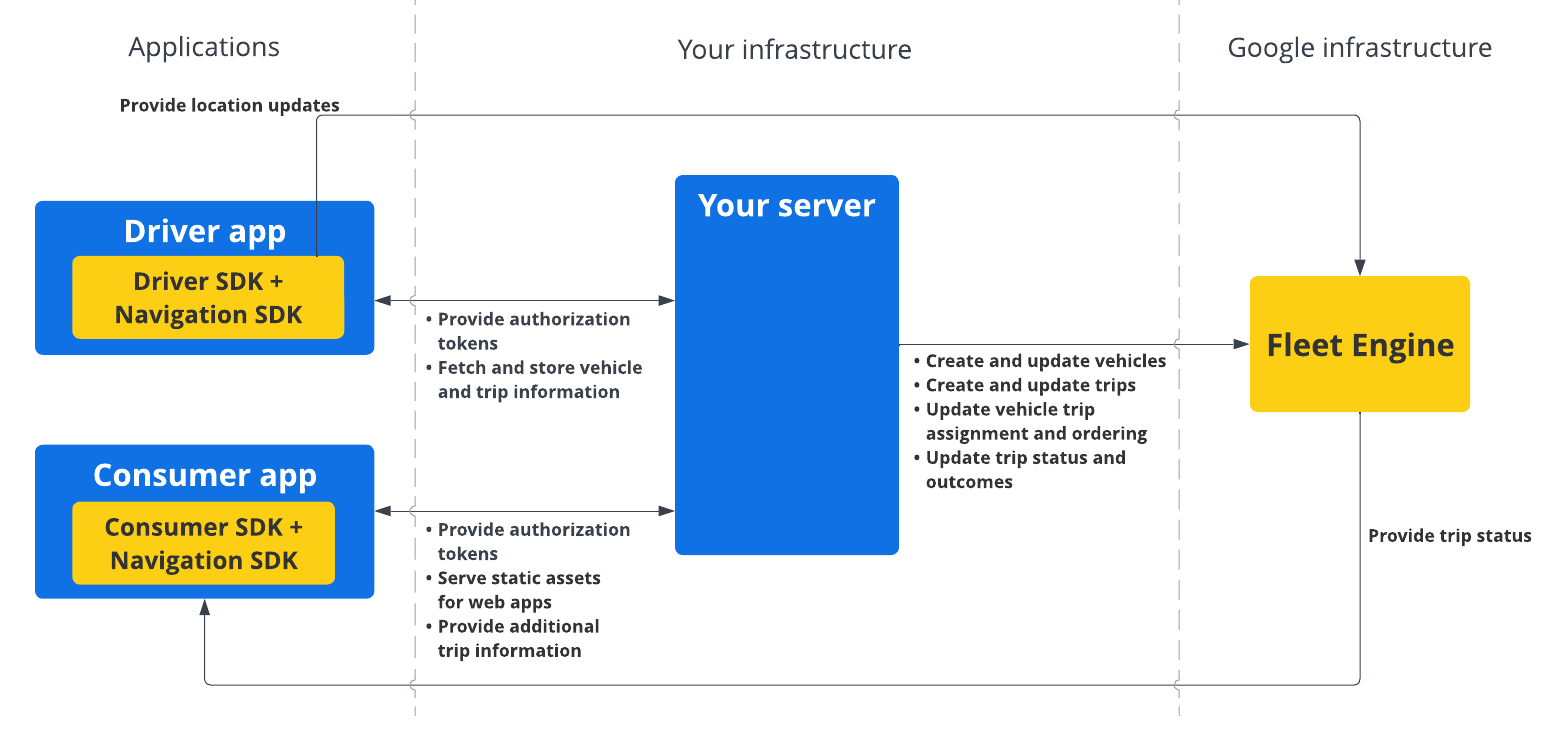El SDK de Driver es un kit de herramientas para apps para dispositivos móviles y un componente fundamental de Fleet Engine. Con este SDK, tu app para conductores puede administrar los viajes asignados y habilitar las funciones de navegación y rutas para conductores.
Antes de comenzar
En esta guía, se supone que ya leíste lo siguiente:
- Aspectos básicos de Fleet Engine
- El modelo de datos para vehículos.
- El modelo de datos para viajes a demanda.
- Cómo configurar Fleet Engine
- Cómo crear y usar vehículos en Fleet Engine
¿Qué es el SDK para conductores para viajes bajo demanda?
El SDK del controlador comunica las actualizaciones de la ubicación del vehículo y del viaje a Fleet Engine para que este pueda hacer un seguimiento de los vehículos y sus viajes asignados. En esencia, el SDK usa un objeto de escucha de eventos para enviar actualizaciones de la ubicación y coordenadas de latitud y longitud, junto con el tramo de ruta y el destino actuales del SDK de Navigation a Fleet Engine cuando el conductor comienza a conducir.
¿Por qué usar el SDK de conductor para viajes bajo demanda?
El SDK de Driver permite una integración más sencilla con Fleet Engine para las actualizaciones de las rutas del conductor. Con este SDK, tu conductor puede usar una sola app para administrar las asignaciones y navegar como lo haría con la versión para consumidores de Google Maps, pero sin tener que cambiar a otra app.
Qué puedes hacer con el SDK para conductores para viajes bajo demanda
Usa el SDK del Driver para viajes a pedido para comunicar lo siguiente a Fleet Engine:
- Posición en tiempo real de un vehículo en un mapa
- Coordenadas de latitud/longitud para los puntos de ruta del viaje proporcionadas por el SDK de navegación.
- Es la distancia restante hasta el siguiente punto de ruta.
- Hora estimada de llegada al siguiente punto de ruta.
- Es la ruta que debe tomar el vehículo, según lo proporciona el SDK de Navigation.
Cómo funciona el SDK para conductores en viajes bajo demanda
El SDK del controlador depende del SDK de navegación para obtener la información de enrutamiento y el destino. Junto con la información del SDK de navegación, el SDK del conductor se integra con su aplicación para conductores y proporciona a Fleet Engine un flujo constante de actualizaciones de ubicación, coordenadas de latitud/longitud, distancia restante y horas estimadas de llegada. Todas las demás actualizaciones de datos de vehículos se deben enviar al backend del cliente, que retransmite los datos a Fleet Engine.

Cómo usar el SDK de Driver para viajes a pedido
Selecciona tu plataforma para ver cómo comenzar a usar el SDK de Driver.
Android
| 1 | Obtén el SDK de Driver para Android | Para obtener más información, consulta Cómo obtener el SDK de Driver. |
| 2 | Configura un proyecto de la consola de Google Cloud | Para obtener más información, consulta Cómo configurar un proyecto de la consola de Google Cloud. |
| 3 | Cómo declarar dependencias | Para obtener más información, consulta Cómo declarar dependencias. |
| 4 | Crea tokens de autenticación | Para obtener más información, consulta Crea tokens de autenticación. |
| 5 | Inicializa el SDK de Driver | Para obtener más información, consulta Inicializa el SDK de Driver. |
| 6 | Prepara el vehículo | Para obtener más información, consulta Cómo preparar el vehículo. |
| 7 | Configura los detalles del viaje | Para obtener más información, consulta Cómo establecer los detalles del viaje. |
iOS
| 1 | Obtén el SDK de Driver para iOS | Para obtener más información, consulta Cómo obtener el SDK de Driver. |
| 2 | Configura un proyecto de la consola de Google Cloud | Para obtener más información, consulta Cómo configurar un proyecto de la consola de Google Cloud. |
| 3 | Crea tokens de autenticación | Para obtener más información, consulta Crea tokens de autenticación. |
| 4 | Inicializa el SDK de Driver | Para obtener más información, consulta Inicializa el SDK de Driver. |
| 5 | Prepara el vehículo | Para obtener más información, consulta Cómo preparar el vehículo. |
| 6 | Configura los detalles del viaje | Para obtener más información, consulta Cómo establecer los detalles del viaje. |
¿Qué sigue?
Consulte la documentación de la plataforma en la que desea configurar el SDK del controlador:

